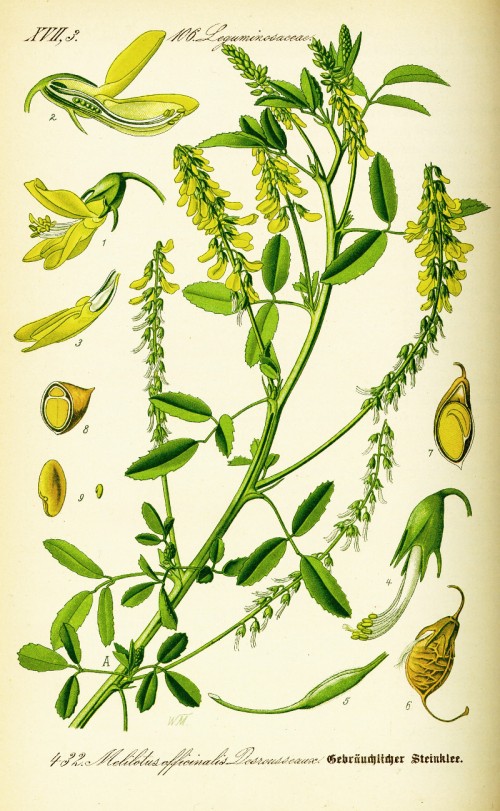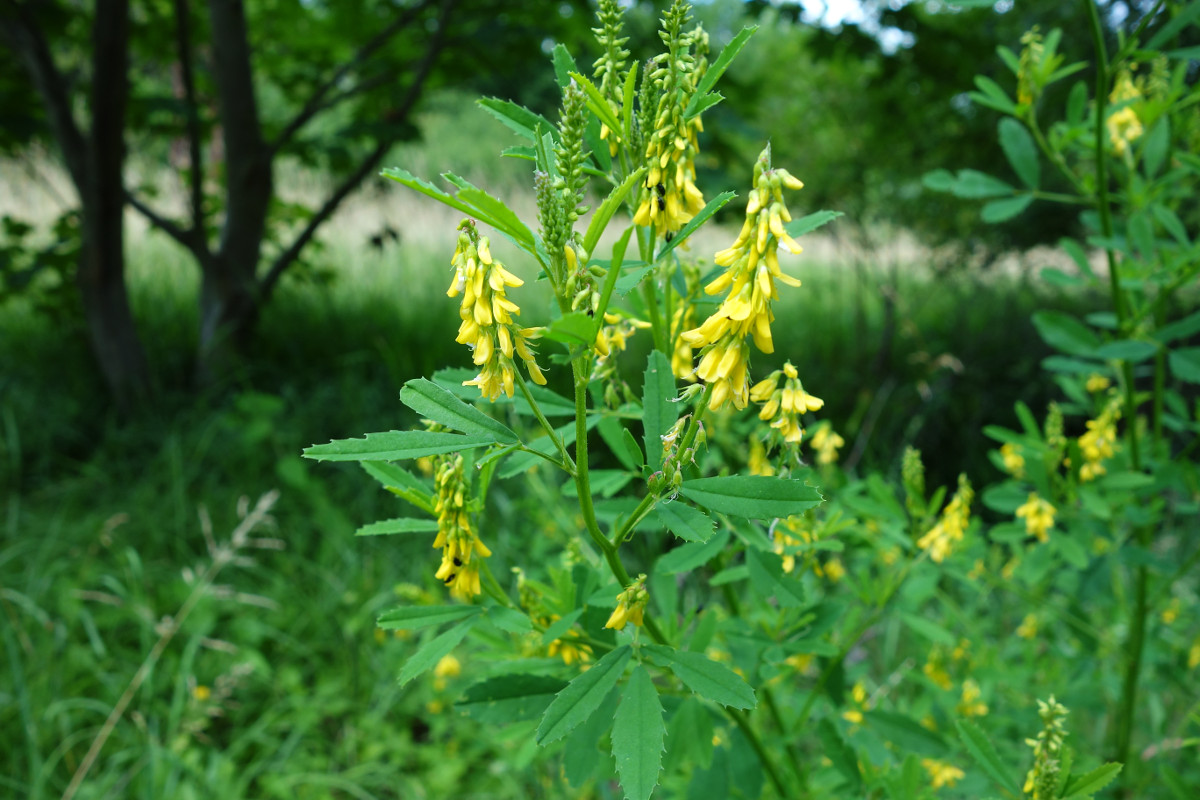Melilotus officinalis (L.) Lam. - syn.Trifolium officinale L. - Fabaceae
common melilot, ribbed melilot, yellow sweet clover, Echter Steinklee
Biennial herb, 0.30-1m high, native to Europe and Asia, naturalized in North America; leaves trifoliate, dentate; flowers yellow, 5-7mm long, ovary and fruit glabrous.
http://www.efloras.org/florataxon.aspx?flora_id=2&taxon_id=200012219
„Extracts are used to treat the symptoms of venous and lymphatic insuffiency and capillary fragility, such as varicose veins, pruritus, cramp in the calf and in acute attacks of haemorrhoids… Coumarin shows anti-oedemic and anti-exudative activities and accelerates wound-healing. It increases the flow rate in veins (and the lymph system) and decreases capillary permeability but has no anticoagulant properties.“ [Medicinal Plants of the World. Ben-Erik Van Wyk and Michael Wink, Pretoria 2004, 203]
(for cumarin toxicology, see also Galium odoratum)
In living plants, coumarin is glycosidically bound as melilotoside, an odorless precursor. On wilting or injuring, o-coumaric acid (o-hydroxy-trans-cinnamic acid) is released from the glucoside; o-trans-coumaric acid is in equilibrium with the cis-coumaric acid, which then spontaneously lactonizes to coumarin. Coumarin is the aroma impact compound of wilted or dried M.officinalis.
[Hagers Handbuch der Pharmazeutischen Praxis, Springer 2010]
Coumarin alone made up more than 89% of all volatiles collected from M.officinalis. An extract obtained by solid-liquid extraction of dry sweet clover herb could be fractionated to identify minor volatile components. Higher proportions of coumarin derivatives such as 3,4-dihydrocoumarin, dihydrocoumaric acid methyl and ethyl ester could be found. Other minor components are anethol, 4-methoxy benzaldehyde (anisaldehyde), 2-hexadecanone, and cresol eg.; γ-pentadecalactone was regarded as species indicator compound among the 84 components identified from M.officinale volatiles.
[Volatile constituents of sweet clover (Melilotus officinalis L. Lam.)., Wörner, M., Schreier, P., Zeitschrift für Lebensmittel-Untersuchung und Forschung, Vol.190(5), 1990, 425-428]
HPLC of an ethanolic extract prepared from air-dried leaves of M.offcinalis revealed 18 phenolic compounds, predominantly representing coumarins, flavonoids, and derivatives of phenolocarboxylic acids. Main components were ferulic acid (25.0%), arbutin (14.9%), caffeic acid (12.5%), chlorogenic acid (6.8%), rutin (6.2%), hyperoside (5.8%), cinnamic acid (4.6%), coumarin (3.8%). Minor constituents were hesperidin (2.0%), vitexin (1.3%), 4-oxycoumarin (0.15%), and luteolin (0.03%).
[HPLC analysis of phenolic compounds in yellow sweet-clover., Bubenchikova, V.N., Drozdova, I.L., Pharmaceutical Chemistry Journal, Vol.38(4), 2004, 195-196]
„The chemical composition of the leaves oil of Melilotus officinalis (L.) Pallas grown in Colombia was studied by GC and GC-MS. Thirty-five volatile compounds were identified, of which the most prominent were coumarin (35.3 %) and (Z)-3-hexen-1-ol (25.9 %).“
[Chemical composition of the leaves essential oil of Melilotus officinalis (L.) pallas from colombia., Quijano-Celis, C.E., Pino, J.A., Morales, G., Journal of Essential Oil Bearing Plants, Vol.13(3), 2010, 313-315]

Thomé,O.W., Flora von Deutschland Österreich und der Schweiz, Tafeln, vol.3 t.432 (1885)
http://plantgenera.org/species.php?id_species=655188

Melilotus officinalis, CC BY-SA 3.0, Author: Andreas Kraska


